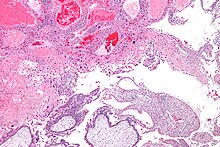
Back مرض ورم الأرومة الغاذية الحملي Arabic Malaltia trofoblàstica gestacional Catalan Enfermedad trofoblástica gestacional Spanish بیماری تروفوبلاستیک بارداری Persian Maladie trophoblastique gestationnelle French Gestacijska trofoblastična bolest Croatian 임신영양막병 Korean Gestācijas trofoblastiskā neoplāzija Latvian/Lettish ഗർഭകാല ട്രോഫോബ്ലാസ്റ്റിക് രോഗം Malayalam गर्भारकालीन ट्रोफोब्लास्ट आजार Marathi
| Gestational trophoblastic disease | |
|---|---|
 | |
| Micrograph of intermediate trophoblast, decidua and a hydatidiform mole (bottom of image). H&E stain. | |
| Specialty | Oncology |
Gestational trophoblastic disease (GTD) is a term used for a group of pregnancy-related tumours.[1] These tumours are rare, and they appear when cells in the womb start to proliferate uncontrollably. The cells that form gestational trophoblastic tumours are called trophoblasts and come from tissue that grows to form the placenta during pregnancy.
There are several different types of GTD. A hydatidiform mole also known as a molar pregnancy, is the most common and is usually benign. Sometimes it may develop into an invasive mole, or, more rarely into a choriocarcinoma. A choriocarcinoma is likely to spread quickly,[2][3] but is very sensitive to chemotherapy, and has a very good prognosis. Trophoblasts are of particular interest to cell biologists because, like cancer, they can invade tissue (the uterus), but unlike cancer, they usually "know" when to stop.[citation needed]
GTD can simulate pregnancy, because the uterus may contain fetal tissue, albeit abnormal. This tissue may grow at the same rate as a normal pregnancy, and produces chorionic gonadotropin, a hormone which is measured to monitor fetal well-being.[4]
While GTD overwhelmingly affects women of child-bearing age, it may rarely occur in postmenopausal women.[5]
- ^ "Gestational Trophoblastic Disease—Patient Version - NCI". www.cancer.gov. National Institute of Health. Retrieved 3 May 2024.
- ^ Seckl MJ, Sebire NJ, Berkowitz RS (August 2010). "Gestational trophoblastic disease". Lancet. 376 (9742): 717–29. doi:10.1016/S0140-6736(10)60280-2. PMID 20673583. S2CID 32138190.
- ^ Lurain JR (December 2010). "Gestational trophoblastic disease I: epidemiology, pathology, clinical presentation and diagnosis of gestational trophoblastic disease, and management of hydatidiform mole". American Journal of Obstetrics and Gynecology. 203 (6): 531–9. doi:10.1016/j.ajog.2010.06.073. PMID 20728069.
- ^ Gestational trophoblastic disease: Epidemiology, clinical manifestations and diagnosis. Chiang JW, Berek JS. In: UpToDate [Textbook of Medicine]. Basow, DS (Ed). Massachusetts Medical Society, Waltham, Massachusetts, USA, and Wolters Kluwer Publishers, Amsterdam, the Netherlands. 2010.
- ^ Chittenden B, Ahamed E, Maheshwari A (August 2009). "Choriocarcinoma in a postmenopausal woman". Obstetrics and Gynecology. 114 (2 Pt 2): 462–5. doi:10.1097/AOG.0b013e3181aa97e7. PMID 19622962. S2CID 35996436.